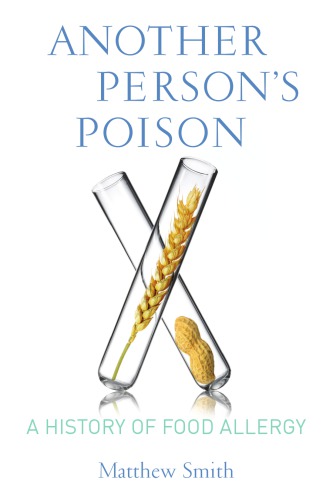
Another Person's Poison
A History of Food Allergy
تاریخچه آلرژی غذایی
کتاب های مرتبط
- اطلاعات
- نقد و بررسی
- دیدگاه کاربران
نقد و بررسی

April 15, 2015
A scholarly history of food allergy. Smith (Health and Healthcare/Univ. of Strathclyde; Hyperactive: The Controversial History of ADHD, 2012, etc.) writes that food allergy has been riven by ideological controversy since the word "allergy" was coined in 1906. Sure, the ancients knew that some foods made people sick. However, at the turn of the 20th century, little was known about the immune system, and all doctors could go by was patient reports of headaches or upset stomachs when they ate certain foods. Moreover, the skin tests used to diagnose hay fever or asthma were unreliable in detecting food allergies. So practitioners split into two camps: orthodox allergists believed that few food allergies existed; others saw a cornucopia of problematic foods, which after World War II, grew to include food dyes and other additives. Some became "clinical ecologists" who added the dangers of modern environments and developed elaborate toxicity tests and elimination diets. By the 1960s, the discovery of the immune system molecules responsible for allergic reactions led orthodox allergists to increase their limited roster of allergy-causing foods. Then came the peanut. In the 1990s, there was a rash of sensational stories of children dying within minutes of unwittingly imbibing traces of peanut or even food cooked in peanut oil. The resulting paranoia led to today's bans on serving peanuts on airplanes and in other public places, along with educational alerts. But how do we account for the rise in peanut and other food allergies and autoimmune diseases? It's frustratingly elusive, writes the author, who cites popular theories like the hygiene hypothesis as well as the hope for peanut desensitization therapies. But as a historian, he is more interested in a century's lack of medical research to find answers than in defending old dogmas and definitions, a situation he finds parallel to the history of psychiatry. While Smith's text sometimes reads like a doctoral dissertation, all that meticulousness adds weight and authority to the evidence of the serious shortcomings of a medical specialty.
COPYRIGHT(2015) Kirkus Reviews, ALL RIGHTS RESERVED.

April 15, 2015
The study of food as a source of allergies had a rocky start; it was initially treated as a spurious field. It was with the relatively recent appearance of peanut allergies and the attendant complications, including a higher fatality rate, that food allergies took a serious turn in the public arena. Smith (Hyperactive) explains that there are two major schools of thought regarding food allergies: the conservative group aligns with immunology principles, then there are the doctors, patients, and parents who see the problem on a clinical level that affects them on a daily basis. Smith recounts with great detail and effective anecdotes the related political, commercial, and professional clashes that have taken place for more than a century and continue to this day. Thorough research is evidenced throughout the title with the inclusion of exhaustive footnotes and a comprehensive bibliography that fills one-third of the book. Smith covers the different arguments effectively and evenhandedly, giving the rationale for each faction's perspective. VERDICT This excellent resource is strongly recommended for those interested in the history of health research, including undergraduates, graduates, and medical professionals.--Deb West, Gannon Univ. Lib., Erie, PA
Copyright 2015 Library Journal, LLC Used with permission.

June 1, 2015
An estimated 8 percent of children and 4 percent of adults in North America are allergic to some type of food. Milk, eggs, peanuts, soy, and seafood top the list. Yet the notion of food allergy has a somewhat controversial history. Medical historian Smith tracks the past and present story of food allergies and their emergence as a genuine health problem. Allergies arise when the immune system responds excessively to a foreign substance, such as proteins or chemical additives. Smith details the difficulty in defining and diagnosing food allergy. He chronicles the tensions between orthodox (conventional) allergists and food allergists, clinical experience and immunological research. He presents the facts about peanut allergy, in which severe symptoms and even death can be provoked by tiny amounts of peanut protein. Anaphylaxis, skin testing, RAST testing, Immunoglobulin E (IgE), desensitization, oral immunotherapy, and even parasitic worms wiggle their way into Smith's informative discussion. While much remains to be discovered about food allergies, Smith capably introduces readers to the complex and confounding connection between what we eat and our bodies' adverse reactions.(Reprinted with permission of Booklist, copyright 2015, American Library Association.)

























دیدگاه کاربران